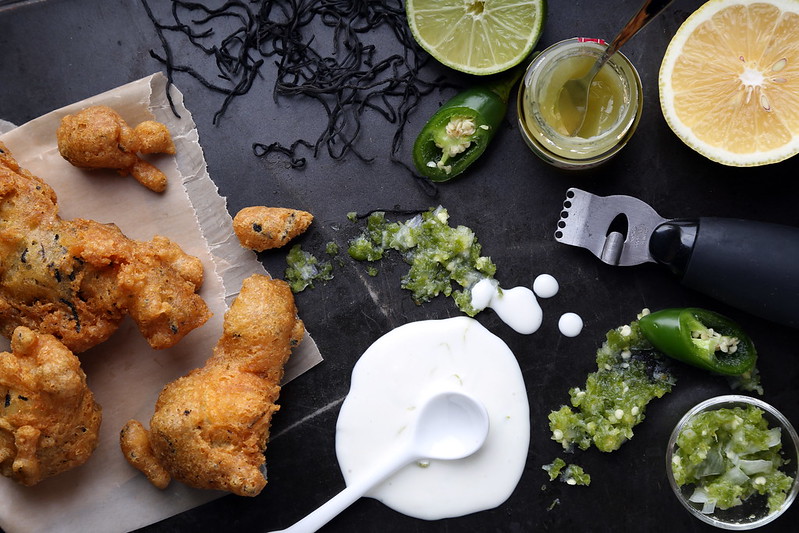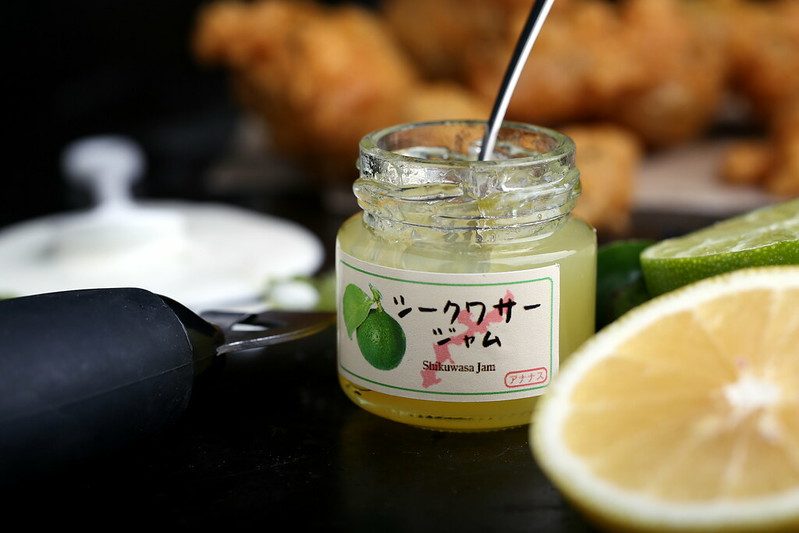
When I started this blog (it will be three years this January!), my original intent was to challenge myself in the kitchen, show skeptics of veganism that it isn’t gross or weird and enjoy the creative and collaborative energy created between me (doing the cooking and food styling), and my husband, who has taken almost every photograph you see on this site.
An unexpected but welcome result of this endeavor has been connecting with a vast and diverse number of people and entities—vegan bloggers, chefs, authors, companies and activists—which is important to me, because when I first decided to go vegan almost eight years ago, it was kind of a lonely and isolating thing to do. So the virtual connections I’ve made with countless like-minded and veg-curious individuals over the past three years is something I will always be grateful for.
One of the connections I have enjoyed the most is with Leila, an American artist living in Okinawa, Japan. She has made a staggering number of recipes from this blog, and has provided insightful and helpful feedback for each one, which has helped me grow tremendously with developing and improving upon the content on this site. In addition to her wonderful support, she also opens up wonderful dialogue about food and culture she finds interesting on her own, which includes both vegan and non-vegan trends. It has been wonderful to connect with someone who is as enthusiastic and passionate about food as I am!
About a month ago, Leila very kindly and generously sent me some Japanese and specifically Okinawan products to try out. And when I say “some,” I mean two large boxes overflowing with a staggering bounty of wonderfully new, delightfully weird and refreshingly unfamiliar products. Everything was tiny or delicate, wrapped up beautifully and with care, and so fun to look at because it was so foreign to me—and most of it had to be figured out through questions to Leila (who purposefully left out descriptions of the items, to make it more fun to figure out … which it did!) and googling them on my end.

Once my feelings of being overwhelmed subsided, I began to think of ways to incorporate and combine some of these gifts into dishes for the blog and have thoroughly enjoyed researching these new-to-me products along the way. One of the first things I made with some of these products was a bookmarked recipe—Seaweed and Tofu Beignets with Lime Mayonnaise—from the September 2013 edition of Bon Appétit by Chef Ari Taymor of Alma Restaurant in Los Angeles. Although the recipe was buried towards the end of the issue and required eggs, I kept thinking about it, intrigued by its ingenuity, simple complexity and thoughtfulness.
For this application, I decided to use some of the naga-hijiki and shikuwasa jam included in the packages Leila sent, and subbed Ener-G and Vegenaise to replace the eggs that the original recipe and method relies heavily upon. The results here were fantastic: these beignets are impossibly fluffy and airy on the inside and incredibly crispy on the outside, mind-blowingly rich throughout, and perfectly complimented with the intensely sour and subtly spicy paste and sauce it’s served with.
Recipe heavily adapted from Bon Appétit.

Get This Recipe In Your Inbox
Share your email, and we’ll deliver it straight to your inbox.
Plus, enjoy new content every week as a bonus!

SEAWEED-TOFU BEIGNETS WITH JALAPEÑO AND SHIKUWASA JAM PASTE
- Total Time: 45 minutes
- Yield: 4 appetizer-sized portions
Ingredients
for the lime mayonnaise
- 1/3 cup Vegenaise
- zest of one lime
- juice from 1/2 lime
- large pinch of salt
for the jalepeño-shikuwasa jam paste
- zest of one lemon
- flesh of one lemon
- 1 jalepeno, chopped
- 1 TB shikuwasa jam
- pinch of salt
for the beignets
- 1/4 cup seaweed (I used naga-hijiki)
- 1/2 cup 00 or AP flour
- 1/4 cup rice flour
- 3/4 tsp baking soda
- 3/4 tsp salt
- 1 tsp Ener-G, whisked with 2 TB water
- 3 TB silken tofu
- 3/4 to 1 cup of plain carbonated water
- canola oil, for frying
Instructions
To make the lime mayonnaise
- Whisk together all of the ingredients in a small bowl. Cover and chill.
To make the jalepeño-shikuwasa jam paste
- Place the lemon zest, flesh and jalepeno into a small processor. Process until smooth, then pass through a fine-mesh sieve. Transfer the contents left in the sieve into a small bowl, then add in the shikuwasa jam and salt. (You can toss or reserve the leftover liquid in another application if you like.) Cover and chill.
To make the beignets
- Place the seaweed into a bowl and cover with plenty of warm water to soften for about 10 minutes. The seaweed will expand considerably during the time. Drain the water off the seaweed and refill the bowl again with enough warm water to cover the seaweed and soak again while you make your beignet batter.
- Place the 00 or AP and rice flour, baking soda and salt into a large bowl. In a separate bowl, whisk the Ener-G and water together. Add in the silken tofu and carbonated water (start with 3/4 cup) and whisk until smooth, then add it to the flour mixture, combining it together gently until well-blended. Add a bit more carbonated water as needed to achieve a pancake batter-like consistency. Do not overmix.
- Drain the seaweed and give it a squeeze with your hands to remove some of the excess water. Roughly chop, then fold into the batter.
- Place several inches of canola into a small saucepan. Heat over medium-high heat for several minutes. You can either use a deep-fry thermometer to confirm a 350-degree temperature or just insert a wooden spoon into the bottom of the pan. If bubbles form around the wooden spoon immediately, you are ready to fry.
- Drop tablespoon-sized amounts of batter into the hot oil (only 3 or 4 at a time), and fry for about 4 minutes or until deeply golden brown, flipping them around to ensure even frying. Transfer to paper towels to drain. If your oil gets too hot, just lower the temperature slightly in between batches to prevent burning.
- Serve the beignets immediately with the chilled lime mayo and sweet and spicy jam paste.
Notes
- The leftover oil can be completely cooled, strained and stored in the refrigerator and used a couple more times before discarding it.
- I used the leftover batter the next day to make savory pancakes—I just added a bit of baking soda to the batter, then poured 2 TB-sized portions into a hot oiled skillet, frying for a few minutes on each side over medium high heat.
- Cook Time: 45 minutes







